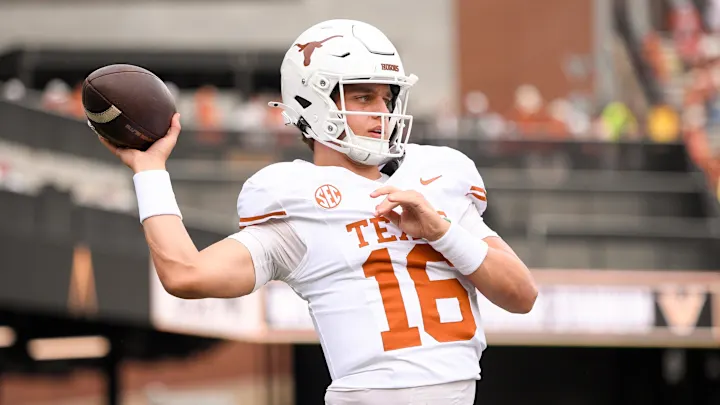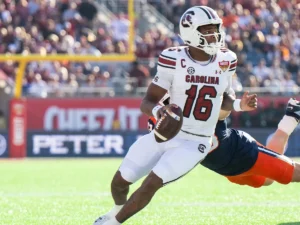
Julian Sayin at Quarterback: Ohio State’s Strategic Response to Arch Manning’s Texas Move
quarterbacks at the forefrIn recent years, the world of college football has witnessed an evolution in recruiting strategies, with eliteont of this shift. The recruitment of Julian Sayin by Ohio State can be seen as part of this larger trend. As one of the most highly touted quarterbacks of his generation, Julian Sayin’s commitment to Ohio State holds significant ramifications not just for the Buckeyes, but for the larger college football landscape. The arrival of Arch Manning at Texas only adds another layer to the complex web of quarterback recruitment and competition in the sport, making Sayin’s recruitment and potential development at Ohio State a strategic response by the Buckeyes to the changing dynamics of college football.
In this analysis, we’ll delve into how Julian Sayin’s recruitment represents Ohio State’s attempt to solidify their position at the top of the college football world and how it may serve as a reaction to the growing influence of Texas and Arch Manning in the college football quarterback race.
Before diving into the specifics of Julian Sayin’s recruitment and its connection to Arch Manning, it’s important to understand the broader shifts in college football recruiting. Over the past two decades, college football has increasingly become a game dominated by top-tier quarterbacks, many of whom serve as the face of their programs. Teams that recruit elite quarterbacks gain a significant edge, and schools like Alabama, Clemson, Georgia, and Ohio State have invested considerable resources into developing their quarterback pipelines.
The introduction of the Transfer Portal has only intensified this arms race, as top quarterbacks can now quickly move between programs in pursuit of playing time, championship contention, or simply a better fit. This mobility has made recruiting and retaining top talent more competitive than ever. In this environment, securing a quarterback like Julian Sayin is not just about filling a roster spot; it’s about ensuring the team’s future success and positioning itself against rivals, particularly those in the SEC and other major power conferences.
When Arch Manning, the highly sought-after quarterback from New Orleans, committed to Texas in 2023, it sent ripples throughout the college football recruiting world. Manning, the grandson of Archie Manning and nephew of NFL legends Peyton and Eli Manning, entered the recruiting world with immense pressure and expectations. His commitment to Texas was seen as the Longhorns’ return to national prominence. Texas, with its rich football history and the aura surrounding the Manning name, quickly became one of the most talked-about programs in college football, with many projecting that Manning could lead the Longhorns to a new era of dominance.
Arch Manning’s decision to play for Texas, a school that has not been a consistent national contender in recent years, represented a shift in the college football landscape. While Texas had the potential for a resurgence under head coach Steve Sarkisian, the recruitment of Manning signaled that Texas could once again become a destination school for top-tier talent. The buzz surrounding Manning’s arrival at Texas quickly made the Longhorns one of the most discussed programs in the country. This created immediate pressure on rival programs to respond.
Ohio State, under head coach Ryan Day, has long been one of the most successful programs in college football, particularly in developing elite quarterbacks. The Buckeyes have produced top-tier quarterbacks like Dwayne Haskins, Justin Fields, and CJ Stroud, all of whom have had successful careers in the NFL. As one of the premier programs in college football, Ohio State has a reputation for not only recruiting elite talent but for developing them into future stars.
In the face of the Texas resurgence, fueled by the arrival of Arch Manning, Ohio State’s reaction was strategic. The Buckeyes recognized that to maintain their position as one of the nation’s elite programs, they would need to continue securing top-tier quarterback talent. Enter Julian Sayin, a quarterback who had been attracting attention from nearly every major program in the country.
Sayin, a 5-star recruit out of California, is a prototypical quarterback prospect with the kind of talent that could lead Ohio State for years to come. His blend of arm strength, mobility, and football IQ has drawn comparisons to some of the best quarterbacks in the country. His ability to read defenses and make quick decisions under pressure has set him apart from his peers. His high school performances in California, often against some of the best competition in the nation, have proven his readiness for the next level.
Ohio State’s recruitment of Sayin can be seen as a response not only to the growing talent pool in college football but also as a direct reaction to Arch Manning’s commitment to Texas. Manning’s move to Texas potentially altered the competitive landscape in the Big 12 and beyond, making it all the more important for Ohio State to solidify their position at the top of college football. By securing Julian Sayin, Ohio State ensured that they would not only compete with Texas but with other elite programs such as Alabama, Georgia, and Clemson for national championships in the years to come.
Ohio State has established itself as a quarterback factory in recent years, consistently producing top-tier NFL talent. The success of Justin Fields and CJ Stroud, both of whom were highly recruited and developed into first-round NFL draft picks, is a testament to Ohio State’s ability to cultivate quarterbacks. Ryan Day, the offensive-minded head coach, has been instrumental in developing quarterbacks into NFL-caliber talent, and this track record is a key reason why Julian Sayin would be drawn to the program.
Ohio State’s offense is one of the most potent in college football, featuring dynamic playmakers at almost every position. With a wide receiver corps that routinely produces NFL talent and a solid offensive line, Ohio State’s system provides a perfect environment for a quarterback like Sayin to thrive. Additionally, Ohio State’s emphasis on balance—running the ball effectively while also creating opportunities for explosive passing plays—fits well with Sayin’s skill set. The combination of a proven system and a commitment to quarterback development likely played a significant role in Sayin’s decision to commit to Ohio State.
While much of the national conversation surrounding recruiting is centered around the SEC and the rise of programs like Texas, the Big Ten remains one of the most competitive conferences in college football. Ohio State is consistently at the forefront of the Big Ten, but the increasing strength of teams like Michigan and Penn State, as well as the overall rise of Big Ten recruiting, means that the Buckeyes must continue to innovate and recruit elite talent.
Julian Sayin’s commitment solidifies Ohio State’s position not only as the premier program in the Big Ten but also as a national contender for years to come. As long as the Buckeyes continue to develop elite quarterbacks, they will remain a constant threat in the race for the College Football Playoff and national championships.
The rivalry between Ohio State and Texas, particularly in the context of quarterback development, is poised to be one of the most exciting storylines in college football over the next several years. While Arch Manning’s move to Texas has generated a great deal of excitement, Julian Sayin’s commitment to Ohio State should not be underestimated. Sayin represents the future of Ohio State’s offense, and his presence at quarterback ensures that the Buckeyes will be a force to be reckoned with as they aim to compete with Texas, Alabama, Georgia, and others for national supremacy.
This is not just about recruiting one player; it’s about positioning Ohio State as a long-term contender. With Arch Manning potentially leading Texas into a new era, Ohio State’s acquisition of Sayin ensures that the Buckeyes will not be left behind. Both programs now find themselves locked in an arms race to develop the next generation of elite quarterbacks, and the outcome of this competition will have a significant impact on the college football landscape for years to come.





